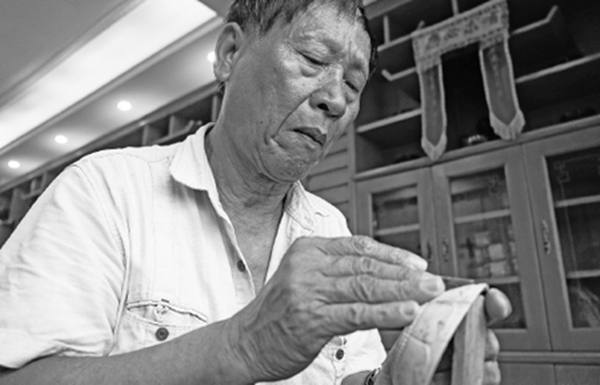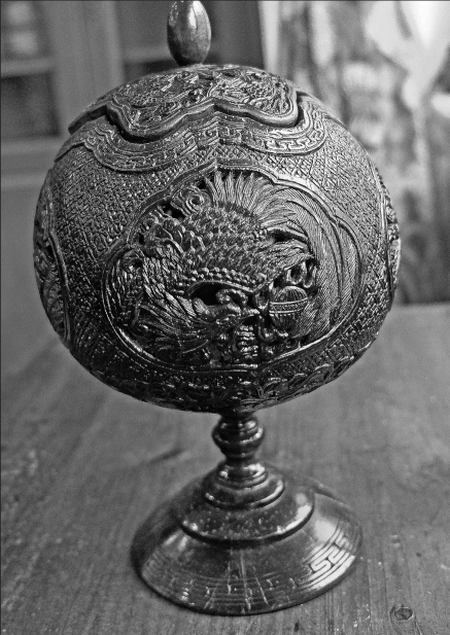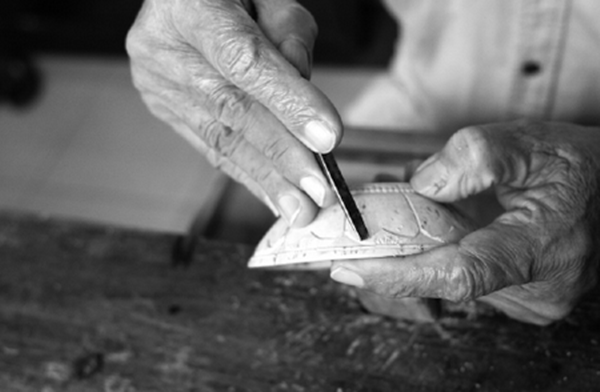
Zhang Xingfu says he got his carving knives 59 years ago, and for them to be effective all he needs to do is sharpen them from time to time. [Photo by Liu Xiaoli/China Daily]
Zhang Xingfu, 72, usually starts his day by carving a coconut shell at 8 am, sitting near the window with knife and shell in hands, something he has been doing for the past 50 years.
In fact, Zhang, a master of coconut carving in Haikou, Hainan province, could sit in his chair without leaving it until midnoon, so absorbed is he with the matter at hand.
Zhang, who was interested in drawing as a youngster, started to learn coconut carving when he was 13. He was paid just 15 yuan a month, he says, but he was happy.
"I didn't care about the pay. I was just happy that I was learning something that was related to drawing."
He had to learn how to peel and polish coconuts and how to draw before he finally got into the process of carving, and it was three years before he could turn out his first work.

A work of Zhang. [Photo by Liu Xiaoli/China Daily]
The job calls for great patience-which is perfect for Zhang, who sees himself as a very patient man-and it takes about a month to produce a single carving.
The factory Zhang first worked in received many orders before the 1980s, and most were tourist souvenirs. But Zhang considered that there was more to his craft than that, and he studied hard with his teachers Lin Shixian, Gao Yusheng and Chen Yijin, renowned coconut carving masters in Hainan.
The dedication paid off when Zhang was chosen to work on two vases made from coconut shells that the government of Hainan was to present to Macao as a gift in 1999. Zhang was one of just 300 workers chosen to work on the project.
"It was a great honor and I was extremely proud," Zhang says.
Those in the craft regard the two vases, 1.99 meters high, with a maximum diameter of 800 centimeters, and weighing 80 kilogram each, as masterpieces. They are made from 5,200 coconut shells of similar color and luster, and about 32,000 sweet-scented osmanthus and 60,000 grains of sand form part of the finished vases.

Coconut carving calls for great patience and sometimes Zhang can sit in his chair without leaving it from 8 am to mid-noon. [Photo by Liu Xiaoli/China Daily]
"We spent the whole year on those two vases," Zhang says.
With those two works, Zhang's fame in the craft was assured.
The Hainan government also gave one of Zhang's works as a gift to Singapore's prime minister, Lee Hsien Loong, in 2013.
Ten years earlier, Zhang had left the carving factory but remained devoted to his craft.
"The factory shut down and most of the workers moved on to other things," he says. "Only a few are still coconut carvers."
Zhang has been invited to various cities and counties in Hainan to teach young people the craft, and at one stage he had a shop in Haikou in which he gave lessons free of charge. However, he was forced to close the shop after a year because the rent was too onerous.
Zhang has had many students from far and wide, including overseas, over the years, but most have eventually given up, he says.
"You can't really pass on your carving skills that easily, and it is difficult to make enough money to make ends meet, especially if you have a family to support. Still, I really want the craft to continue, so I am willing to teach anyone who is willing to learn."
This year Zhang, never too old to learn, went to Suzhou, Jiangsu province, to learn something more about his craft.
"I got the chance to work with a professional drawing teacher, and it helped me a lot. Drawing is the essential skill in coconut carving."
Now that his two children have grown up he can devote himself even more to carving, he says.
Coconut carving is regarded as a low-cost craft compared with sculpture and other forms of art. Zhang says he got his carving knives 59 years ago, and for them to be effective all he needs to do is sharpen them from time to time.
Coconut shells can easily be bought at the market for about 5 yuan (70 cents) each, and he is expert at discerning the best ones in terms of shape, color and hardness.
"But the perfect coconut shell is like a once-in-a-lifetime chance, a one in a million happening."
Shop owners have a good idea of Zhang's needs and make a point of saving coconuts with any unusual shape for him. In his home he has about 30 of his own works, and people have offered good money for them, but Zhang has turned them down.
"These are family treasures and not for sale," Zhang says.
And in the master craftsman himself, his son Zhang Minjie sees a treasure.
"I admire my father and am proud of him. There is always something I can learn from him."
Contact the writer at liuxiaoli@chinadaily.com.cn